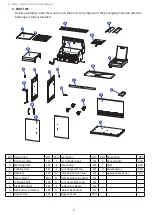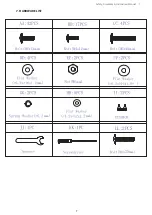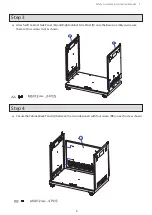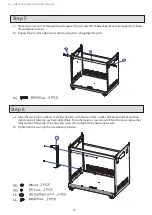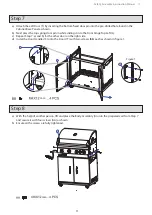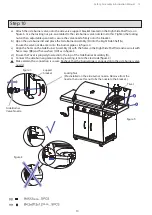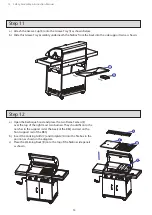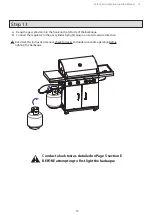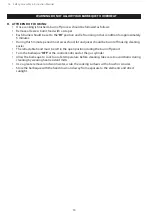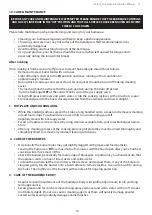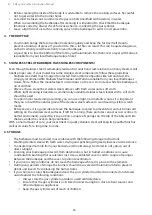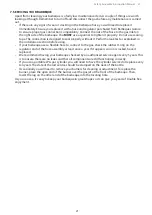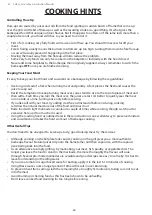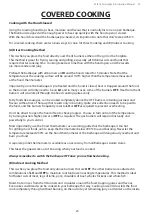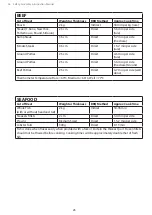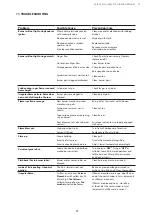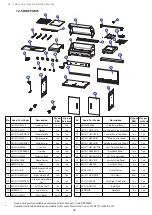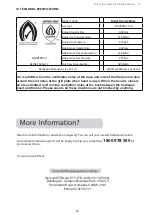
20
20 Safety, Assembly & Instruction Manual
•
Before cleaning the inside of the body it is advisable to remove the cooking surfaces. Be careful
not to get water into the burner holes.
•
Care must be taken not to immerse the gas controls (manifold and injectors) in water.
•
When re-assembling the barbeque after cleaning it is important to check that the barbeque
functions correctly. Always check for leaks when re-connecting the gas cylinder.
•
Leave a light film of oil such as cooking spray on the barbeque to assist in rust prevention.
4. THE DRIP TRAY
• You should change the fat absorbent material regularly and keep the fat tray itself clean to
prevent a build up of grease. If you don’t do this, a fat fire can result. This can be quite dangerous,
and will certianly void the warranty on your barbeque.
• A good tip is to line the bottom of the fat tray with aluminium foil, then cover a layer with Fatsoak
(available from your local Barbeque Galore Store).
5. STAINLESS STEEL (IF BARBEQUE HAS STAINLESS COMPONENTS)
Even though stainless steel is remarkably resistant to tarnish and rust relative to ordinary steels, it still
needs proper care. If your model has some stainless steel components, follow these guidelines:
• Stainless steel lasts much longer if protected from airborne impurities like salt and dust. We
strongly recommend 3M Stainless Steel Cleaner and Polish available from your local Barbeques
Galore Store. Follow the manufacturer’s instructions on the can. Do not use while the barbeque is
on or still hot!
• After each use, clean the stainless steel surfaces with fresh water and a soft cloth.
• Where light cleaning is needed, a commercially available stainless steel cleaner with a soft cloth
should be used.
• To repair minor tea staining or pitting, you can use a light, non-metallic scourer. It is important
that you rub with the natural grain of the stainless steel surface to avoid leaving visible scratch
marks.
• Between uses, it is a good idea to leave the barbeque covered to prevent dust and air borne salts
settling on the stainless steel surfaces. If left for too long, these particles can act as rust centres. In
humid enviroments, a good tip is to position a couple of sponges on the top of the bbq and side
shelves, under the cover, to help ventilation.
With a small amount of care, your investment in quality stainless steel will keep its beautiful finish as
well as its value for a long time to come.
6. STORAGE
• The barbeque must be stored in accordance with the following storage instructions.
• Washing stainless steel with fresh water, drying and polishing will greatly increase rust resistance.
•
To ensure maximum life from your barbeque it should always be stored in a dry place, out of
direct sunlight.
•
Covering your barbeque protects it from deterioration, but in humid conditions can cause
condensation build up that accelerates rust. Use a ventilated cover or add a couple of sponges
between the barbeque and the cover to promote ventilation.
•
If you live in salty conditions, do not leave the barbeque where it is prone to the elements.
•
During long periods of storage the burners should be covered with aluminium foil to prevent
debris and insects from blocking the burner holes.
•
If you choose to store the barbeque indoors, the gas cylinder must be disconnected and stored
outside under the following conditions:
o
Always store the gas cylinder outside in a well ventilated area.
o
Ensure that the gas cylinder is not stored in direct sunlight or close to heat sources and
other dangerous appliances.
o
Keep the gas cylinder out of reach of children.

